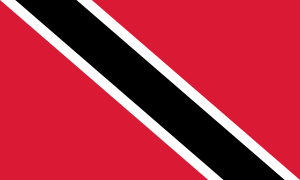Arima
Arima, officially The Royal Chartered Borough of Arima is the easternmost and second largest in area of the three boroughs of Trinidad and Tobago. It is geographically adjacent to Sangre Grande and Arouca at the south central foothills of the Northern Range. To the south is the Caroni–Arena Dam. Coterminous with Town of Arima since 1888, the borough of Arima is the fourth-largest municipality in population in the country (after Port of Spain, Chaguanas and San Fernando). The census estimated it had 33,606 residents in 2011.[3]
Arima | |
|---|---|
| The Royal Chartered Borough of Arima | |
 The Dial in the Central Business District | |
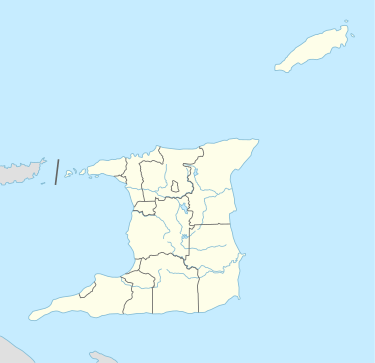 Arima 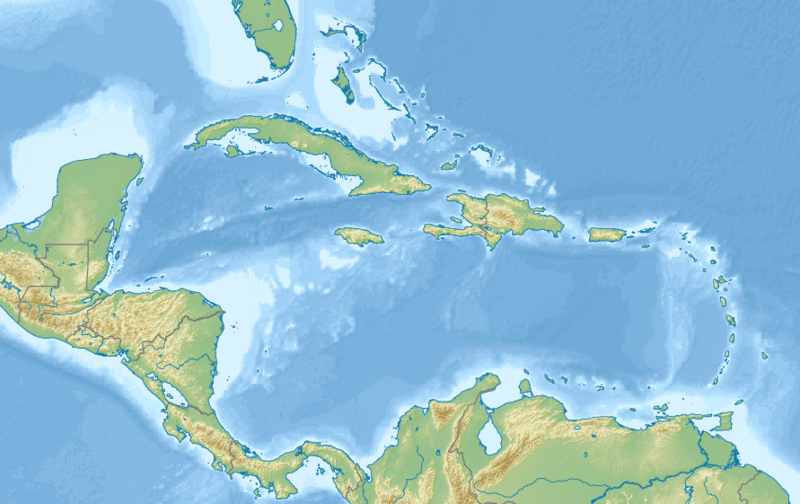 Arima  Arima | |
| Coordinates: 10°38′N 61°17′W | |
| Country | |
| Jurisdiction | The Royal Chartered Borough of Arima |
| Settled | 1757 |
| Borough | 1 August 1888 |
| Named for | The Amerindian word for Water. It was so named as Arima was built around a river. |
| Government | |
| • Mayor | Lisa Morris-Julian |
| • Governing body | Arima Borough Corporation |
| Area | |
| • Borough | 12 km2 (5 sq mi) |
| Elevation | 68 m (223 ft) |
| Population (2011) | |
| • Borough | 33,606 |
| • Rank | 4th |
| • Density | 2,801/km2 (7,250/sq mi) |
| • Urban | 65,623 |
| Demonym(s) | Arimans |
| Time zone | UTC-4 (AST) |
| Postal Code | 30xxxx, 36xxxx[2] |
| Area code(s) | 868 |
| ISO 3166 code | TT-ARI |
| Telephone Exchange | 664, 667 |
| Website | arimaborough |
| HDI The HDI for Trinidad and Tobago is 0.814, which gives the country a rank of 19th out of 177 countries with data (2007/2008) – high | |
In 1887, the town petitioned Queen Victoria for municipal status as part of her Golden Jubilee celebration. This was granted in the following year, and Arima became a Royal Borough on 1 August 1888. Historically the third-largest town of Trinidad and Tobago, Arima is fourth since Chaguanas became the largest town in the country.
Geography
Climate
The borough has a tropical rainforest climate (Köppen Af), bordering on a tropical monsoon climate, characterised with little seasonal variations due to its close proximity to the Northern Range. Temperatures typically range from 20 to 31 degrees, and annual rainfall averages around 2000 millimeters. The wet season lasts from June to November, and although there is no true dry season, there is a noticeably drier stretch from January to April.[4] Hail has occurred in the town but is rare.
Culture and entertainment
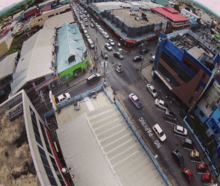
Arima hosts an annual Borough Day anniversary celebration in August. The celebration incorporates Carnival-style street parades and usually coincides with the staging of the Santa Rosa Carib Community annual festival. The annual Arima Carnival includes street parades of masqueraders on Carnival Tuesday, J'ouvert bands on Carnival Monday, as well as a local calypso competition.
Demographics
Ancestry
| Year | Pop. | ±% |
|---|---|---|
| 1980 | 24,112 | — |
| 1990 | 26,528 | +10.0% |
| 2000 | 28,310 | +6.7% |
| 2011 | 33,606 | +18.7% |
| Racial composition | 2011[5] |
|---|---|
| Multiracial | 38.3% |
| Black (Afro-Trinidadian/Tobagonian) | 31.5% |
| South Asian (Indo-Trinidadian) | 15.4% |
| Dougla (South Asian and Black) | 7.1% |
| White Trinidadian | 0.02% |
| East Asian (Chinese) | 0.3% |
| Native American (Amerindian) | 0.2% |
| Arab (Syrian/Lebanese) | 0.06% |
| Other | 0.14% |
| Not stated | 6.4% |
Transportation
Highways and roads
The major land transportation arteries are the Churchill–Roosevelt Highway, Eastern Main Road and the Priority Bus Route which all link Arima with major towns and cities along the East–West Corridor metropolitan area. Among other important routes are the Arima Bypass, Cocorite Street, Tumpuna Road and O'Meara Road which links neighbourhoods around the town to the Town Center.
Transit
Arima plays an important role for north-eastern Trinidad as a multi-modal transportation hub for many of the towns and neighbourhoods on the eastern side of the island. A bus terminal provides service by the PTSC Bus network to Sangre Grande, Mundo Nuevo, Blanchisseuse, Carapo, Malabar, Morne La Croix, La Horquetta, Brasso Seco and to the capital Port of Spain.
Maxi taxis (private, owner-operated minibuses) operate throughout Trinidad and Tobago as a kind of semi-public transport. They operate along fixed routes, have fixed fares and meeting points, but do not operate under a fixed schedule. These maxi taxis provide services from the town center to Port of Spain via the Priority Bus Route and Churchill-Roosevelt Highway, making stops along the East–West Corridor. They also provide transport to Sangre Grande.
Sports
The major national super-league team, FC Santa Rosa and Arima Football League, which is based at the Arima Velodrome.
Abilene Wildcats Athletic Club, Trinity College East Athletics Club, Silver Bullets Athletic Club, D'Abadie Progressive Athletic Club, and Spartans High Speed Performance Athletic Club are also based in Arima.
Most suburbs, communities and neighbourhoods around the Borough have their own sporting complexes and community swimming pools.
The three (3) major sporting arenas in Arima are:
- The Larry Gomes Stadium
- Arima Velodrome
- Santa Rosa Race Track Sunil Narine is the only West Indies cricket player to be born in Arima.
Attractions
- Asa Wright Nature Centre, located in Arima Valley, it has a nature walk and swimming at a freshwater pond.
- Santa Rosa Carib Centre, located on Paul Mitchell Road, off De Gannes Street in Arima, it contains items from Arima's native Carib history. It also has displays about Carib descendants in Arima. Native items are also available for purchase.
- Cleaver Woods, it has nature walks and Amerindian exhibits.
Utilities
Electric generation is handled by Powergen, while electrical distribution is handled by the Trinidad and Tobago Electricity Commission (T&TEC). Powergen has natural gas fired generation plants at Point Lisas, Penal, and Wrightson Road in Port of Spain. Additional power can be supplied from power generation facilities controlled by Inncogen at Point Lisas.
Telecommunications are regulated by the Telecommunications Authority of Trinidad and Tobago (TATT). It has been working to break up the monopoly, granting several new licences in 2005 to new companies in the market. Fixed-line telephone service is a monopoly controlled by Telecommunications Services of Trinidad and Tobago (TSTT). Licenses have been granted for competition in this area, but start-up is a while away. Wireless telephony is controlled by TSTT and bmobile, as well as Digicel, which came later. Licenses have been granted for a private company, Laqtel, to offer wireless service in competition with TSTT and Digicel. However, Laqtel had its licence revoked, and is undergoing severe financial difficulties.
Digital cable television is provided by Flow. High-speed internet service of up to 100Mbit/s and digital landline telephone service are all available in Arima.
Water and sewerage are under the purview of the Water and Sewerage Authority of Trinidad and Tobago (WASA).
Education
There are several primary (private and public) and secondary educational institutions in Arima, and some post-secondary level technical training institutes. St. Joseph's Convent in Arima was closed many years ago and the building now houses a retreat centre called Emmaus Centre.
Schools
Primary
- Arima Hindu Primary School
- Arima Boys' Government Primary School
- Arima Boys' R.C. Primary School
- Arima Centenary Government Primary School
- Arima Girls' Government Primary School
- Arima Girls' R.C. Primary School
- Arima New Government Primary School
- Arima Presbyterian Primary School
- Arima West Government Primary School
- Christian Primary Academy
- EdenWay Pre-Primary Christian School
- Giuseppi Preparatory
- Malabar Government Primary School
- Malabar R.C. Primary School
- New Dawn Preparatory
- Santa Rosa Government Primary School
- St. Hilary's Preparatory
Secondary
- Arima Government Secondary School
- Arima Senior Comprehensive (now Arima North Secondary School)
- Holy Cross College
Post-secondary Institutions
- Ambi's Career Institute
- College of Professional Studies
- Zenith Educational Institute
Gallery
 Bus terminal
Bus terminal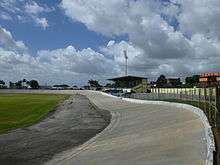 Arima Velodrome
Arima Velodrome Arima Velodrome
Arima Velodrome
References
- "Elevation of Arima,Trinidad and Tobago Elevation Map, Topo, Contour". floodmap.net. Retrieved 5 April 2016.
- "List of Postal Districts". TTPOST. 29 July 2018. Retrieved 29 July 2018.
- "Trinidad and Tobago 2011 Census" (PDF). Ministry of Planning and Sustainable Development. 30 November 2012. Archived from the original (PDF) on 24 September 2015. Retrieved 15 September 2015.
- , Climate Arima, Climate-Data.org
- Central Statistical Office. "Non-Institutional Population by Sex, Age Group, Ethnic Group and Municipality" (PDF). Archived from the original (PDF) on 19 October 2017. Retrieved 6 December 2017.
- Anthony, Michael (2001). Historical Dictionary of Trinidad and Tobago. Scarecrow Press, Inc. Lanham, Md., and London. ISBN 0-8108-3173-2.
External links
| Wikivoyage has a travel guide for Arima. |
- Arima Borough Corporation Official website
- Articles from Nalis marking Arima's 112th anniversary as a borough.
- Article from Nalis marking Arima's 109th anniversary as a borough.
- Some pictures of Arima from TriniView.com showing many streets.
- Cleaver Woods at wcities.com
- Santa Rosa Carib Community
- Newsday: Arima Carnival Results
- Guanaguanare – the Laughing Gull. Carib Indians in Trinidad – includes 2 videos
